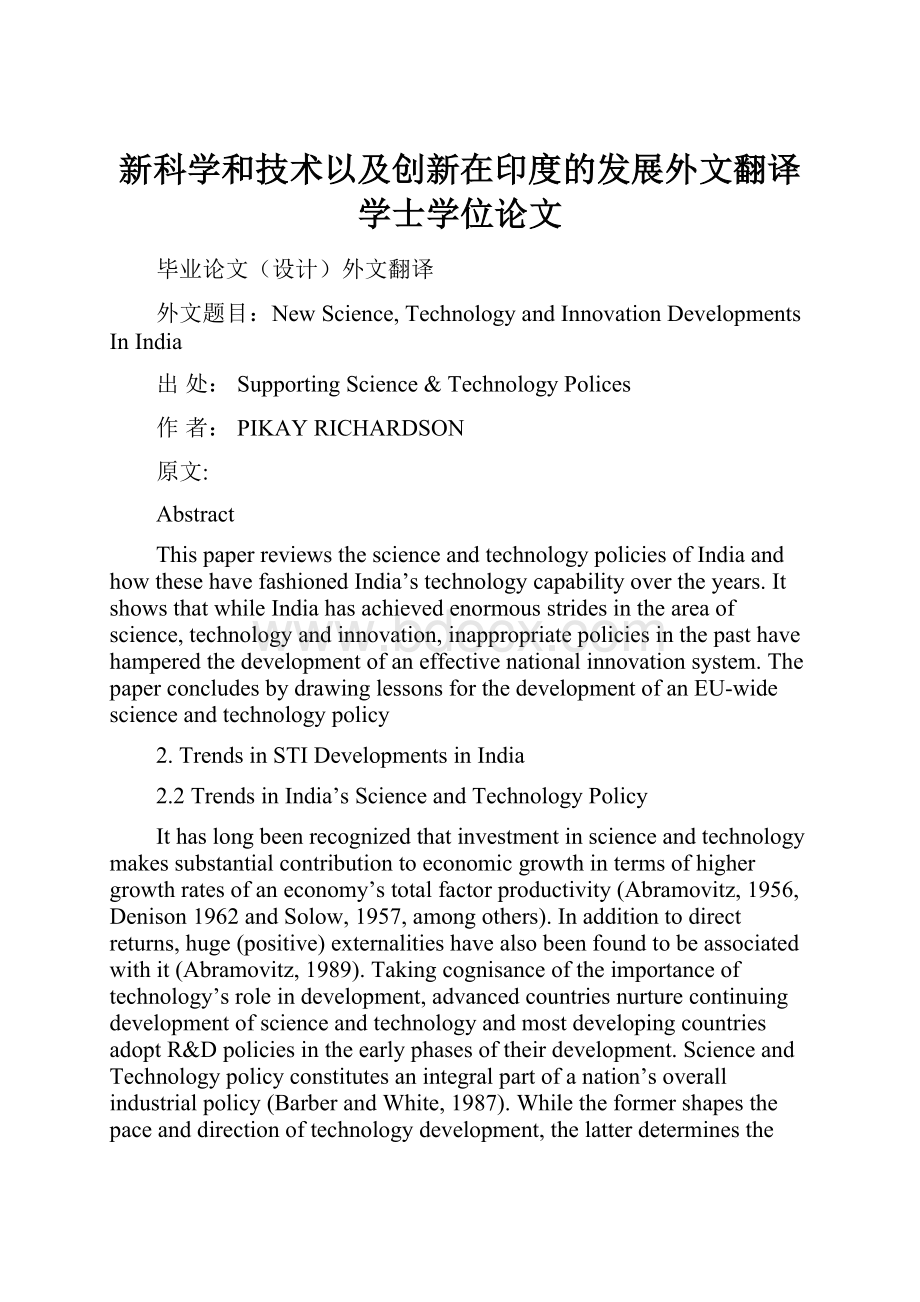新科学和技术以及创新在印度的发展外文翻译 学士学位论文.docx
《新科学和技术以及创新在印度的发展外文翻译 学士学位论文.docx》由会员分享,可在线阅读,更多相关《新科学和技术以及创新在印度的发展外文翻译 学士学位论文.docx(11页珍藏版)》请在冰豆网上搜索。

新科学和技术以及创新在印度的发展外文翻译学士学位论文
毕业论文(设计)外文翻译
外文题目:
NewScience,TechnologyandInnovationDevelopmentsInIndia
出处:
SupportingScience&TechnologyPolices
作者:
PIKAYRICHARDSON
原文:
Abstract
ThispaperreviewsthescienceandtechnologypoliciesofIndiaandhowthesehavefashionedIndia’stechnologycapabilityovertheyears.ItshowsthatwhileIndiahasachievedenormousstridesintheareaofscience,technologyandinnovation,inappropriatepoliciesinthepasthavehamperedthedevelopmentofaneffectivenationalinnovationsystem.ThepaperconcludesbydrawinglessonsforthedevelopmentofanEU-widescienceandtechnologypolicy
2.TrendsinSTIDevelopmentsinIndia
2.2TrendsinIndia’sScienceandTechnologyPolicy
Ithaslongbeenrecognizedthatinvestmentinscienceandtechnologymakessubstantialcontributiontoeconomicgrowthintermsofhighergrowthratesofaneconomy’stotalfactorproductivity(Abramovitz,1956,Denison1962andSolow,1957,amongothers).Inadditiontodirectreturns,huge(positive)externalitieshavealsobeenfoundtobeassociatedwithit(Abramovitz,1989).Takingcognisanceoftheimportanceoftechnology’sroleindevelopment,advancedcountriesnurturecontinuingdevelopmentofscienceandtechnologyandmostdevelopingcountriesadoptR&Dpoliciesintheearlyphasesoftheirdevelopment.ScienceandTechnologypolicyconstitutesanintegralpartofanation’soverallindustrialpolicy(BarberandWhite,1987).Whiletheformershapesthepaceanddirectionoftechnologydevelopment,thelatterdeterminesthenatureofdemand.ThissectionreviewstheevolutionofScienceandTechnologypolicyinIndiasinceindependence。
ScienceandTechnologypolicyofanynationiscarvedwithinthebackgroundofoverallindustrialpolicy.Ifanything,S&Tpolicyissupposednotonlytogivemeaningto,butmoreimportantly,toensureachievementofthegoalsofindustrialpolicy.ItisthereforethethrustanddirectionofindustrialpolicythatdeterminesthetenetsofanyS&Tpolicy,althoughitmustbesaidthatR&Dmayleadtoresultsthatmayalsochangethecourseofindustrialpolicy.Evenso,S&Tpolicyhasalmostalwaysbeendrivenbythegoalsofindustrialdevelopmentpolicy.ThissectionthereforedescribesthedevelopmentstrategyadoptedbythegovernmentinthevariousphasesofdevelopmentandanalysestheaccompanyingS&Tpolicy.TwostrandsofS&Tpolicyhaveexisted–policiesrelatedtotechnologytransferfromabroadthroughformalmodessuchasFDI,technologylicensingandcapitalgoodsimportsanddomestictechnologygenerationpolicies.Havingrealizedthatthepursuitofautarkiceconomicpoliciesinmuchofthepost-independenceperiodto1990wasamistake,Indiaundertooksweepingreformsasawayofspeedingeconomicgrowthandachievingfasterintegrationintotheworldeconomy.Partofthesereformshasbeenthere-enactmentofascienceandtechnologypolicymoresuitedtotheachievementofthegoalsofbuildingaprosperousnation.
3.Responseto/ImpactofReforms
3.2.2GlobalR&DCenters
HirwaniandJain(1999)haveshownthatalthoughmarket-orientedactivitiesweremoreimportanttoMNEsinmostofthe1990s,technologyorientedactivitiesaregrowinginimportance.Hitherto,MNEshadbeenemphasizingastrategyofcustomizingproductsfortheIndianmarketandofobtainingcost-efficientmanufacturingfacilitiesinIndia.Increasingly,however,therehasbeenaclearmovetowardsobtainingaccesstohighqualityscientists,engineersanddesignersinIndia.SomeR&DcenterssetupinIndiabysomeMNEsconductcontractresearchforthecorporatelaboratoriesoutsideIndia.Priorto1991,theestablishmentofsuchR&DcentersbyMNEswasconsciouslylacking.SinceIndiasignedtheGATTAgreementin1993andsubsequentlypassedtheIntellectualPropertylawin1994,over60MNEshavesetupR&Dcentersintechnologyintensiveindustries,mostlytotakeadvantageofthestrongpoolofhighly-trainedengineersandscientists.Before1991,therewereonlytwosuchcentersinthecountry.
ApartfromthesettingupofnewcentersinIndiatotakeadvantageoftheliberalizedatmosphere,theraisond’êtreandmodeofoperationofexistingcentershavealsobeenchangingbythenewmarketenvironment.SomecompanieshavecompletelyrestructuredtheirR&DcentersinIndia,shiftingthefocusfromdevelopingproductsforIndianmarketstomakingthemcentersofglobalexcellence.Othershaveexpandedtheir.operationsandhiredmanyIndianscientistsandtechnologists.Thisismoreevidentintheareasofinformationandcomputertechnology.SuchcentersconductR&Dforworldwideoperations.TheavailabilityofhighqualitylaborhasbeenamotivatingfactorintheestablishmentofcentersbycompaniessuchasAstra,Unilever,GEandSoftwareDevelopmentCentersofTexasInstruments,Oracle,Microsoftandothers.SubstantialR&Dpresencehasalsobeenestablishedintheareasofpharmaceuticalsandbiotechnology.
3.4CommercialOrientationofPublicResearchOrganizations
Indiahasastrongindustrialresearchinfrastructure,whichwasfosteredintheearlystagesofitspost-independencegrowth.Whilethesupply-sidewasgenerously
supported,theindustrialresearchsystem,priortoliberalization,wasmostlygearedto
importsubstitution(BowonderandRichardson,2000).ThepubliclyfundedCouncilofScientificandIndustrialResearch(CSIR)andotherbodiestendedtobeisolatedentitieswithlittleornolinkstoindustry.Insuchaprotectedenvironment,therewasnoneedtobenchmarktheiractivitiestothoseofglobalplayers.Alsotheiractivitieswereonlymarginallyfocusedoncommercialization.Thelastdecadehasseenmanyoftheselaboratoriesbecomemorecommerciallyoriented.TheyhavebeendirectingtheireffortstowardsinternationalqualityR&D.Tworecentmajorpolicythrustshavebeen(a)anincreaseinthequestforpatentinginEuropeandtheUSA,asameansofengenderingastrongdesiretoundertakeR&Dandtoinnovateand(b)anincreaseinthecommercialorientationofindustrialresearch,withaviewtomakingthesebodieslessdependentonpublicbudgetarysupport.
3.6FDISpill-over’sandTechnologicalCapability
LiberalizationpoliciesandtheresponsebybothforeignandIndiancompaniesalikehavehadmanyspilloversthatarevaluableforIndia’stechnologicalcapability.Thegrowthofthesoftwareindustryhashadwide-rangingimpactontheeconomy.Thedemandforsoftwareimportsandthesettingupofforeigndevelopmentcentershavecontributedtotherapidincreaseincompensationlevels,estimatedatanannualrateof25%inthesecondhalfofthe1990s.Otherbenefitshaveincludedstockoptionsandgoodemploymentopportunities,therebyslowingbraindraintosomeextent.ForeignparticipationhasexposedIndianengineersandscientiststonewtechnologiesandmadethemmoresensitivetotheprotectionofintellectualproperty(softwareIPpiracywasestimatedtohaverisenfrom59%to61%between1999and2000(Krishnan,2001).Anotherfactorhasbeenthesharpincreaseintheoutputofdegree-anddiplomaawardinginstitutions.Thenumberofinstitutionsofferingformaldegree-leveleducationinengineeringmorethandoubledbetween1990and2000,from339to776.Studentintakecapacityalsodoubledwith80%riseinthescience/engineeringplaces.
AlthoughventurecapitalorganizationsstartedtoemergeinIndiain1986,thegrowthoftechnology-basedventuresdidnotcatchup.Inthelastdecade,however,therehasbeenasubstantialriseinIT-basedventurecapital.Nigam(2001)recordsthatventurecapitalinvestmentsreached$350millionin2000,asagainstafigureoflessthan$5millionin1995.Alargechunkofthisamount(70%)wasdirectedintotheITsector.Manynewventurecapitalfirmsarebeingsetup,eitherbyIndian-basedindustrialistsandyoungprofessionalsorbyIndiansbasedoverseas.
Althoughrecentstudies(ChandrasekharandBasavarajappa,2001;MehtaandSama,2001)showthattherehasbeenlittlechangeinR&DintensityofIndianindustry,therehasbeenaclearshifttowardincreasedproductdevelopmentandinnovation(KrishnanandPrabha,1999).Thishasbeenaccompaniedbyincreasedawarenessofintellectualproperty(IP)rightsand,byimplication,theimportanceofpatenting.AccordingtotheUSPatentOffice,ofthetenIndia-basedorganizationswhichfiledthelargestnumberofUSpatentsinthe1995-2000period,threeareIndianpharmaceuticalcompanies.TheCSIRhasalsobeenfilingpatentsinIndiaandtheUS,allthisresultofnewoutward-lookingpolicies.
4.ScienceandTechnologyPolicyinRelationtotheMultilateralSystem
IndiaisafoundermemberoftheGeneralAgreementonTariffsandTrade(GATT)1947anditssuccessor,theWorldTradeOrganisation(WTO),whichcameintoeffectonJanuary11995,aftertheconclusionoftheUruguayRoundofmultilateraltradenegotiations.India'sparticipationisbasedontheneedtoensuremorestabilityandpredictabilityininternationaltradewithaviewtoachievingmoretradeandprosperityforitselfandtheothermembersoftheWTO.ThemultilateraltradingsystemadministeredbytheWTOaimstobringaboutorderliness,transparencyandpredictabilityinglobaltradethroughreductionsintariffs,progressiveremovalofnon-tariffbarriers,eliminationoftrade-distortingmeasuresandsystemsofvaluestoserveasguidelinesfornationallegislationtobringaboutuniformityinlawsandregulationseverywhere.
TheestablishmentoftheWTOhascreatedaforumforcontinuousnegotiationstoreconciledifferingandoftentimesconflictinginterestsofmembers.AlthoughthereisunanimityintheprovisionsofInternationalTradetheorythatfreetradeenhancesglobalwelfare,nationalisma